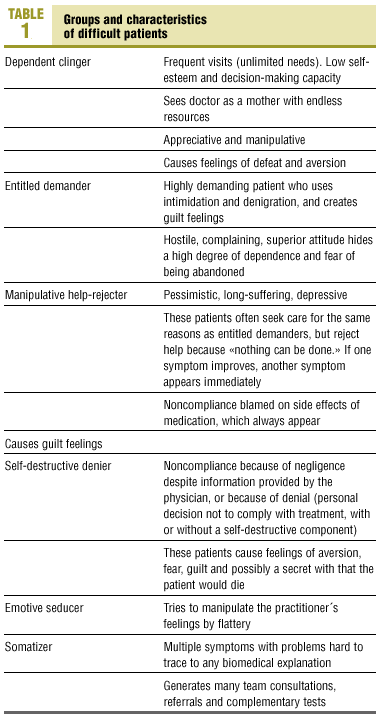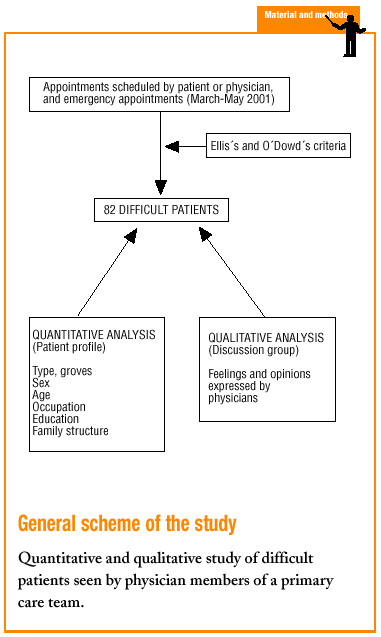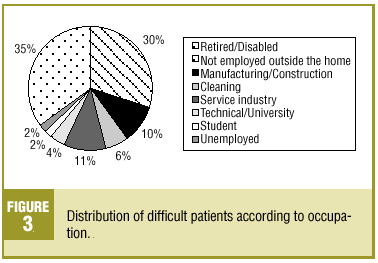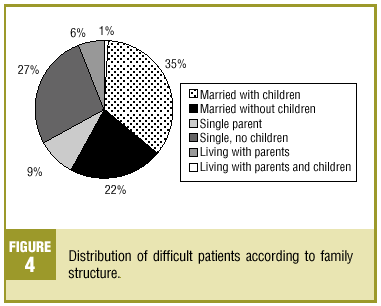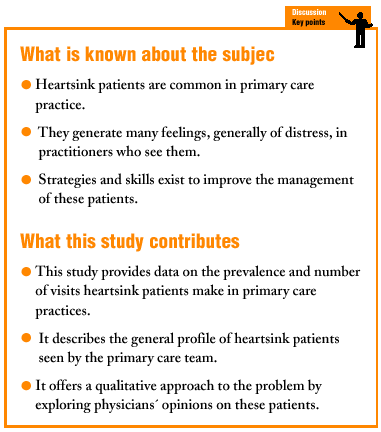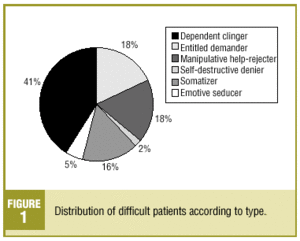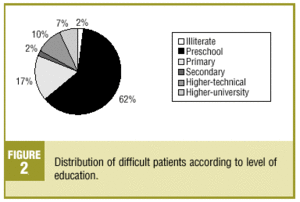Introduction
In connection with doctor-patient relationships, how to manage difficult (heartsink) patients (DP) is a frequent topic of conversation among primary care physicians. These patients evoke a variety of feelings that often include elements of emotional tension, and can contribute to the dreaded professional burnout. Conversations among practitioners suggest that distress is widespread, and in contrast to the situation for specific (especially organic) diseases, there seems to be no common set of skills or strategies for dealing with these patients and improving physician-patient relations.
A number of studies have examined relations with DP. Most describe their characteristics,1-5 the feelings they most often produce,2,6,7 or strategies for managing such patients;2,5-9 other studies have proposed ways to classify them.6 However, few studies mention the prevalence of these patients or the numbers of visits they make.5,10-13 In Spain, a notable study by Blay Pueyo14 defined and characterized problem patients, and proposed strategies for improving their management. Another noteworthy study by Sanz-Carrillo et al.15 reported practitioners´ reactions to somatizer patients. Other texts, such as that by Borrell,16 are of a more general nature. We are aware of no studies that report the opinions of medical team members regarding DP in qualitative terms, or that describe the prevalence and profile of these patients.
The aims of the present study were to identify DP seen by members of a primary care team, to describe the profile of these patients, and to analyze the opinions they generate in the physicians who see them in their daily practice.
Participants and methods
Setting
The study was carried out in the Santa Eulalia Sud urban Basic Health Area (L´Hospital de Llobregat, Barcelona, Spain). The staff consists of 9 family physicians and 3 pediatricians who serve a population of 23 000 inhabitants.
Sample and participants
Six family doctors took part in the study. Two temporary staff doctors were excluded, as was one new staff member whom it was felt did not yet know his patients well enough to provide information on their profiles.
Heartsink patients were selected and classified during the period from March to May 2001. The inclusion criteria were chosen by consensus among the participating physicians as being straightforward and readily applicable: the criteria of Ellis (patients who cause a knot in the stomach when their name appears on the list of patients with an appointment that day),7 and the criteria of O´Dowd (patients who produce distress or discomfort in those who see them).17
From the list of the patients with a scheduled appointment (requested by the patient or scheduled by the physician) or an emergency appointment, the physicians identified patients who satisfied the inclusion criteria noted above. The study variables were number of DP seen, number of visits made by DP, age, sex, type of DP, family structure, level of education, occupation and comorbidity (associated medical or psychiatric problem). Groves´ classification6 was used to identify difficult patients as dependent clingers, entitled demanders, manipulative help-rejecters or self-destructive deniers, and the categories emotive seducer and somatizer were added as recommended by Blay Pueyo14 (Table 1).
Discussion group
A qualitative study was done to record the opinions and experiences these patients generated in the physicians who saw them. Because of its ease of application and suitability for the aims of the present study, we used a focus group approach (discussion group), a qualitative analytical and research technique that consists of a semistructured conversation guided by a moderator with the help of a flexible script based on a series of open questions.18-22 All 9 staff physicians at the center participated in the discussion group. The three physicians who did not participate in the patient selection phase were included. Although being a staff member for only a short time before the study was done may have influenced how they identified DP, we felt that this would not influence their opinions about these patients. The staff health technician at the center acted as the discussion group moderator.
A script that served as the basis for the discussion included the following issues: quantitative and qualitative magnitude of the problem (emotional impact), feelings evoked, management strategies, perception of management skills and need for training. The discussion group met during 1 hour during working hours, and the meeting was tape-recorded for later data analysis. The recording was analyzed by the moderator and one of the participants to identify the opinions expressed most frequently or most strongly, although all opinions considered of interest were noted.
Results and discussion
Characteristics of difficult patients
The 82 patients identified (average of 13.6 patients per physician) represented a prevalence of 0.7%, and generated 2.3% of all visits during the study period. Two-thirds (67.1%) were women and 32.9% were men, and mean age was 57.8 years (standard deviation 15.2 years). The general profile was that of a woman classified as a passive clinger type of patient (41%), with primary level education (62%), retired (35%), married with children (35%), and with two or more medical problems (74.4%) and at least one psychiatric problem (40.2%).
Figures 1 to 4 show the how difficult patients were distributed according to Groves´ classification, educational level, occupation and family structure.
Few studies have evaluated the prevalence of DP and the number of times they visit their doctors. Mathers et al.23 reported a mean of 6 DP per participating physician, with considerable variability ranging from 1 patient to 50 (i.e., from <1% to >3% of the physician´s list of patients). The mean number of DP per physician in the present study was higher, and similar to that reported by Schwenk and colleagues.12 We found less variability between physicians (12 to 19 patients identified as DP), and like Mathers et al., we found that all participants had at least one DP among their regular patients.
The prevalence of almost 15% reported by Hahn et al.11 was notably high. In their study, DP were identified with the help of a questionnaire that participating physicians responded to, which may have avoided recall bias. We believe the facts that the physicians who participated in the present study had held their primary care post for 5 years or longer, and were responsible for similar numbers of patients, helped to stabilize the number of DP, either through mechanisms of mutual adaptation or because patients were allowed to change physicians.
We note that earlier studies have reported the proportion of DP visits as 15%,10 20%5 or even 30%.13 Jackson and Kroenke10 studied only first visits, a factor that introduced significant bias because of the difficulties associated with the first physician-patient encounter. The study by Hahn et al.5 was done in a hospital setting. The rate of DP visits of 2.32% in the present study represents a mean of 30 visits per day per physician, one visit by a DP every 2 days, or 14 difficult encounters per month. We consider that although the prevalence of DP in the present study is lower than that found by others, these patients are more frequent attenders, an important consideration given the impact of these visits.
With regard to the characteristics associated with DP, we found, as did many earlier studies, that more such patients were women,1,4,7,17 and that DP often had complex medical problems (both physical and psychological).3-5,10,11,17,24-27 Although John et al.4 found no differences in family composition, we noted, as did O´Dowd,17 that married persons clearly predominated. O´Dowd also reported a higher employment rate (67%) than we found (25%).
Magnitude of the problem
In consonance with these results, all members of the discussion group felt that the number of DP they saw was not large. However, dealing with these patients involved considerable psychological or emotional distress. The problem can therefore be considered to be qualitative rather than quantitative. All physicians had at least one DP, but they were surprised at how few such patients they actually saw, as they had assumed when they were invited to participate in the study that they would identify many more. We agree with O´Dowd17 that the scarcity of published quantitative data might lead to the perception that the problem is greater than it actually is. This might be explained by the phenomenon of gradual mutual adaptation with time, as reflected by the statements «With time I get to like them» and «I think the two come to an understanding.»
Feelings evoked by difficult patients
Most of the feelings described by Groves6 were expressed by the participants in the present study, although with subtle differences. The most frequently reported feelings were irritability («I get nervous», «I get uptight»,
«I realize that without meaning to, I raise my voice when I speak to them») and frustration, which were noted in relation with all groups of DP. Most participants felt that frequent attenders, a group represented mainly by «dependent clinger» patients, were readily perceived to be difficult patients («They´re like glue», «They stick to everything»), and that their degree of dependency can generate feelings of defeat («On the day you see them, you end up feeling drained») as well as insecurity («In spite of your years of experience, they manage to make you feel insecure since you can´t solve their problem»). This was an important point for many participants, as it led some to resort to referral to other practitioners to «cut down on your own responsibility.» Although the aversion described by Groves as arising in the relationship with dependent clinger patients was not mentioned per se during the discussion session, the tendency to refer the patient to another physician might be understood as a consequence of this feeling. With regard to manipulative help-rejecter patients, the guilt feelings mentioned by Groves were not alluded to, but participants reported feelings of impotence because they could not do anything about the patient´s problem.
We note that although experience accumulated through years of practice might be thought to provide physicians with more skills to manage these situations and patients, physicians continue to experience unease: «I still have problems», «I thought I had it under control but some patients still throw me off balance.» The information published to date regarding the influence of experience is contradictory. In their study of predictors in physicians who saw difficult patients, Jackson and Kroenke10 found no differences in the number of DP identified in connection with years in practice. However, Crutcher and Bass13 reported that more experienced physicians had fewer problematic encounters. Strategies used with difficult patients
Each practitioner described his or her personal strategy, acquired over the years. Referral was used often, but was perceived as a strategy that yielded poor results and was aimed at keeping the patient from complaining or reducing the physician´s distress rather than at solving the patient´s underlying problem. To understand the reasons that led patients to create difficulties, physicians reported occasionally making determined efforts to comprehend the causes or keys to a patient´s particular attitude by asking themselves «Why hasn´t the patient ever smiled at me in all these years?» or «Why isn´t the patient ever satisfied with anything I do?» Some physicians turn to someone in the patient´s immediate circle who might help him or her to understand the patient: «I try to talk to a relative and ask him or her what the patient is normally like.» This approach, which has been proposed and evaluated by others3-5,17 as an intervention that can improve the situation, is difficult within the setting of practices with large patient loads.
Negotiating and making pacts are considered necessary and useful strategies for managing heartsink patients, and often make it possible for the patient and the physician to reach agreement: «Look, this is the last time I´m going to write out prescriptions for you; next time I´m not going to do this.» «I´ll write out this prescription, but first let me explain why I think I shouldn´t be doing this.» Another strategy is to try to place limits on the reasons for visiting the doctor: «With some patients, especially the passive clingers, you could spend all day talking and they´d still never get tired of listening, since they need you to solve their problems. In this group it is very important to be able to stop them from coming, to limit their reasons for coming in, and if necessary to give them an appointment for an interview outside regular hours to be able to spend more time talking with them (but even then they´d use up the time allotted for their scheduled appointment and would never leave.)» It is also important to make patients understand that «as a doctor you have two thousand patients to look after, not just one.» This is a way to try to reduce the patient´s dependency, as Groves6 noted.
Consultation with other members of the health care team is rarely used during regular team meetings. Instead, personal experiences are commented on informally, usually in the hallways; this «gives us a chance to get it off our chest.» However, participants in the present study agreed that being able to talk about patients could be a valid tool, especially when for some reason the patient changes physicians: «If the relationship with the previous physician was bad, it might well turn out to be bad with me too.» In such cases knowing about a difficult patient in advance would allow the physician to prepare a strategy to prevent problems.
Need for training to cope with difficult patients
Most participants felt that specific training in physician-patient relations was inadequate. Almost all had completed a basic course in clinical interviewing, but had not subsequently studied the course contents in depth. Thus practitioners adopted strategies or maneuvers that they had learned on their own: «You learn from your mistakes.» It is worth recalling here that in the study by Mathers et al,23 less training in communication skills and inadequate postgraduate training were associated with the perception of larger numbers of patients as difficult. Other authors2,10 have noted the usefulness of specific training as a tool for improving the management of heartsink patients. Continuous training in aspects of the physician-patient relationship is therefore considered necessary to equip the practitioners with skills that will allow them to make headway in difficult situations.
Conclusions
The profile of heartsink patients in our setting was similar to that described in earlier studies, but the prevalence and rate of visits were lower than expected. Nonetheless, members of the team of physicians who see these patients reported difficulties in dealing with them, emotional distress, and inadequate skills to cope with them. Specific training in strategies to improve the physician-patient relationship is essential. As Ellis proposed,7 we should be able to assist our patients and, while not curing them, help them to resolve their conflicts, and at the same time as noted by Powers8 decrease our level of frustration and the danger of burnout.
We believe our study should be broadened to examine another aspect of the problem: as Jewell2 asked, on the basis of Balint´s view, how much of the problem can be attributed to physicians? Undoubtedly, knowledge of physician-associated factors which, according to some authors,10,23 can be considered predictors of «difficult encounters,» should help to improve the physician-patient relationship under adverse conditions.
Acknowledgements
We thank Dr. Ferran Flor, health technician at our center, for accepting the role of moderator of the discussion group and for reading and suggesting revisions to an earlier version of the paper.







